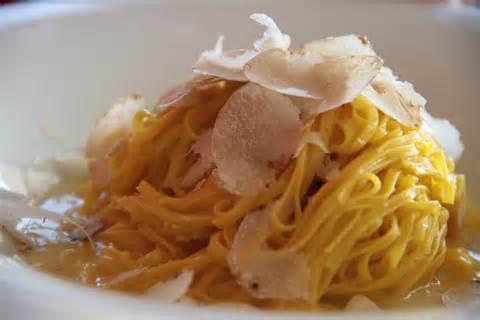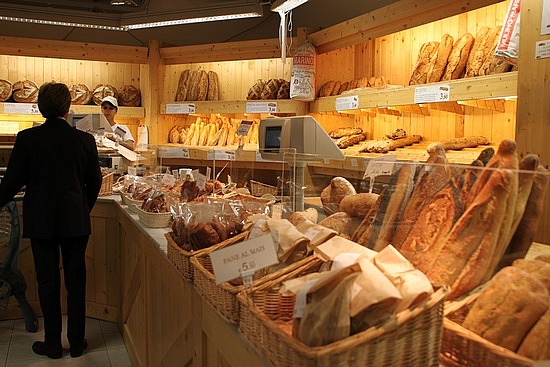Piedmont is especially known for its wide variety of antipasto, meats and especially raw beef, truffles, and is the home of grissini, the breadsticks you can get in some many places of the world. It is close to the French border and the royal family that once ruled Italy, Sardinia, Sicliy and parts of France brought many influences into the region, not the least of which is French, most visible in the cheeses.
The cheeses are much like the soft cheeses of France in shape, texture, aroma and flavor.One cheese dish is the fonduta- fondue- is made with Fontina and butter. T
Bagna Cauda (or bagna caôda) is an antipasto that includes raw vegetables served with a warm garlic, anchovies, olive oil and butter sauce. Other hot appetizers: stuffed squash blossoms deep fired, stuffed Savoy cabbage, and crochette, rice or potatoes croquettes with cheese. Eggs with truffles and onions make tartra piemontese, or baked to form a fritata. Vitello tonnato is veal with a capers and tuna sauce. There is an antipasto called Finanzier, organ meats and mushrooms, Marsala, garlic and vinegar. Terrines and pâtés are made with game birds and liver, in another nod to the French.

Stuffed onions are made with parmigiano, eggs, butter and herbs. Peppers are stuffed with rice, butter, olive oil anchovies and garlic.
Beyond the antipasti is a huge world of flavor and style. Salumi are the family of what we in the US call pepperoni, although pepperoni means ‘peppers’ in Italian. There is an immense variety. Most are made from pork but some from trout, beef, goose, or even potatoes. The most famous is Salamin d’la duja, stored in an earthenware jar stuffed with fat. Prosciutto crudo- in America we call it simply ‘prosciutto’ which means ham in Italian. In Italy you have to specify if you want ‘cotto’ or ‘crudo,’ the latter meaning ‘raw’ but it refers to salted or smoked hams just like in Spain or France.
Rabbit is marinated and made as tender as tuna and thus called tonno di coniglio. You can order “Insalata di carne cruda’ which is raw beef or veal appetizer marinaded in olive oil, lemon juice, and garlic, garnished with truffles in season. Other salads include wild mushrooms, beans, greens, asparagus or sweet and sour onions.
The local pasta is called tajarin, served with beef broth, butter, Grana Padano (a relative of Parmigiano), shaved truffles and nutmet. Meat and herb filled dumplings come with a a sage and butter sauce. Gnocci are served with Fontina, Grana Padano and butter. Polenta is popular in winter – thank goodness we are here in the summer. It is prepared with Toma, a strong soft cheese in the French style, Fontina, butter and Grana Padano. This is called polenta cunsa. There are bean soups, such as cisràand tôfeja, flavored with pork or pork rind.

Tajarin al tartufo
Risotto comes from the rice grown in the region. It might be prepared with sauces made from frogs, meat or vegetables.
Brasato al Barolo is braised beef marinated in red wine. Veal, lamb and baby goat are common. Lepre in civet is rabbit marinated in red wine and cooked with vegetables and herbs.
Piemonte is also known for its hazelnuts. We saw a hazelnut pie in one of the local markets. Candied chestnuts are called marron glaces. Torta gianduia is made with hazelnut and chocolate but no flour. Zabaione are stuffed peaches or chestnuts.
You can also get any other Italian dish at a wide variety of restaurants. Pizza by weight it common if less so than Rome. Lasagna, pesto sauces, grilled or roasted meats, pork chops, you name it, you can find it and many of these are more common than the specialty items which are found in the more exclusive restaurants.
Coffee. Italy serves the best. Last time we spent time here, which was last fall, we went to Spain afterwards. We could barely stomach the coffee for a few weeks. This time we crossed into France, which is very close. We found the coffee to be foul tasting, weak and expensive and were very happy to cross back into Italy, despite enjoying the food in that part of France.
The fresh fruit and vegetables are high quality and inexpensive. We bought a kilo of excellent green figs for less than $3. The watermelon has been as low as $.29 a kilo. Peaches, nectarines, plums are all local, as are apples. Circoria (a bitter green), spinach, fennel, lettuces. The list is endless. I found the big sesame breadsticks at the local market.

The bread- it is astoundingly crusty, and sold with or without seeds, mostly the latter, by weight and very inexpensive. It does not last long but you can freeze it.
Wine. There is a lot of it, it’s good to great, and it’s not expensive. Some of both the reds and white is a bit carbonated (naturally), which we do not care for. Asti is not far and they make the famous Asti Spumante. I may have never had a good one or they are all lousy, I can not say which. You can get wine in enotecas. You can bring your own container for the local inexpensive wine or buy better quality wine by the bottle at the same place or in any grocery store.

For more background on the wine here, see http://www.amoretravelguides.com/blog/torino-italy-wine-wine-and-more-wine.php
There are restaurants galore here, as you would imagine. We stick to the places the locals go to on an every day basis versus the Michelin starred ones. The pork filet with a piece of chesse filled ham on top we had at a local joint where the wine is $9 a half liter for local white. That’s quite a bit more than in Rome but still half of what we were paying in Graz this summer, and this wine is better.

I hope to write more about the wine in another post.




